Dietary blend improves juveniles’ weight gain, feed efficiency and increase body energy deposition, mineral retention
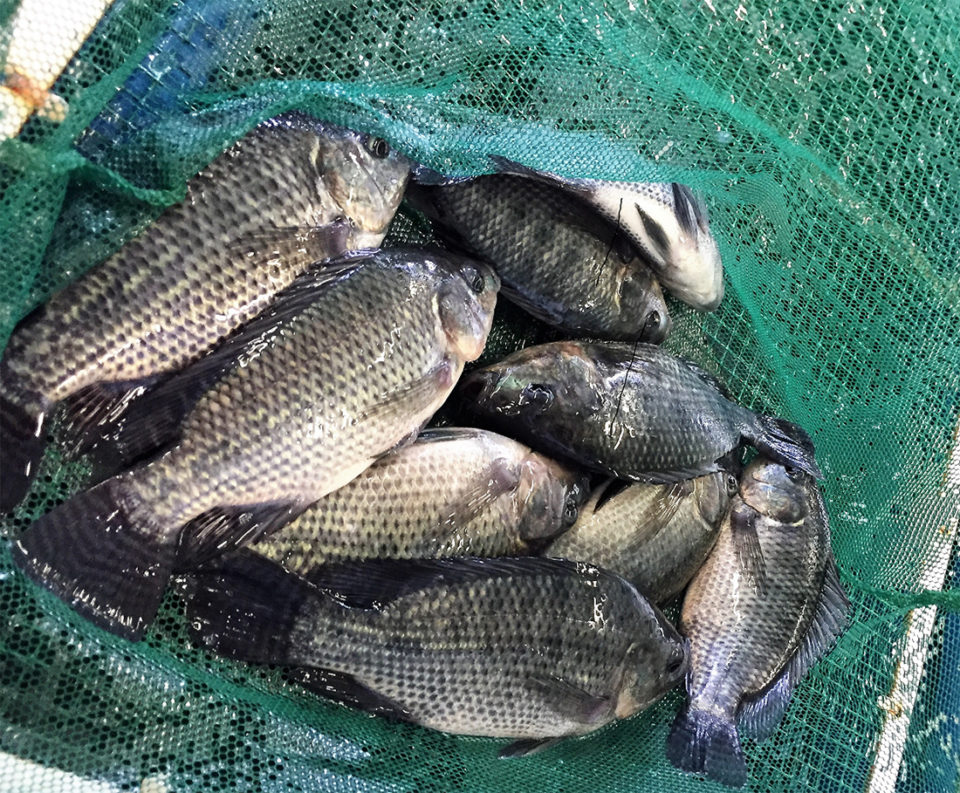
Large amounts of energy-yielding nutrients in plant-based feed ingredients are located in the aleurone layer (which surrounds the endosperm tissue of grass seeds), typically constituted by non-starch polysaccharides (NSP). Most of these nutrients are not hydrolyzed in the digestive tract since fish do not secrete enzymes capable of degrading the non-starch polysaccharides. Supplementation of NSP-degrading enzymes in plant-based diets should reduce their detrimental effects and improve energy and nutrient digestibility, thus increasing growth and feed efficiency of fish.
Corn and wheat bran have a high concentration of xylans (polysaccharides found in plant cell walls and some algae), and whole wheat grain and soybean meal are rich in β-glucan that limits the digestive enzymes from accessing and fully digesting the starch and protein components enclosed within the plant cells. Mixed enzyme preparations might be effectively for degrading a large array of indigestible constituents and increase the access of cell contents in feed to endogenous digestive enzymes contained in feed ingredients. Non-starch polysaccharides-degrading enzymes in cereal and legumes grain diets could help hydrolyze NSP, reducing digesta viscosity and improving energy and nutrients digestibility, thus increasing body-weight and feed efficiency of Nile tilapia fed plant-based diets.
In our study, we investigated the effect of different doses of blends of carbohydrases composed of xylanase and β-glucanase on the growth performance of Nile tilapia juveniles fed mixed corn-soybean meal or wheat-soybean based diets.
Nile tilapia culture
Nile tilapia is the most cultured freshwater fish species in Brazil, both for sports fishing and as a food fish because of its desirable taste, fast-growth, high feed efficiency and high market demand associated to its high versatility for culture in earthen ponds and floating net cages. In recent years, plant-based ingredients – including corn, wheat, soy and co-products – have been used to reduce the cost of aquafeeds, as sustainable energy and protein sources.
However, these feeds contain a high concentration of carbohydrates that consist mainly of non-starch polysaccharides (NSP), and Nile tilapia do not have the enzymes to hydrolyze these carbohydrates. Thus, exogenous carbohydrases could be added to fish diets to mitigate the effects associated with feeding high fiber diets to fish – this is a new frontier in fish nutrition studies. This proposal for our study was approved by the Animal Ethical Committee of the State University of Ponta Grossa (permit number 879/2018).
Study setup
To evaluate the effects of carbohydrases blend, a trial was set up in the Aquaculture Laboratory from State University of Ponta Grossa, PR, Brazil, in a Cooperation Research with State University of Maringá – Animal Science Post Graduating Program, PR, Brazil. Nile tilapia (n = 128; 50.0 ± 1.2 grams initial weight) were randomly stocked into eight 250-liter net cages in a completely randomized in a 2×2 factorial scheme, hand fed until apparent satiety and reared at 28 ± 0.2 degrees-C for seven weeks. Fish feeding was randomized, with the four diets distributed in a 2×2 factorial design, with the factors being source of energy (corn or wheat) and supplementation of XB(non-supplemented or added to feed at 0.2 grams/kg).
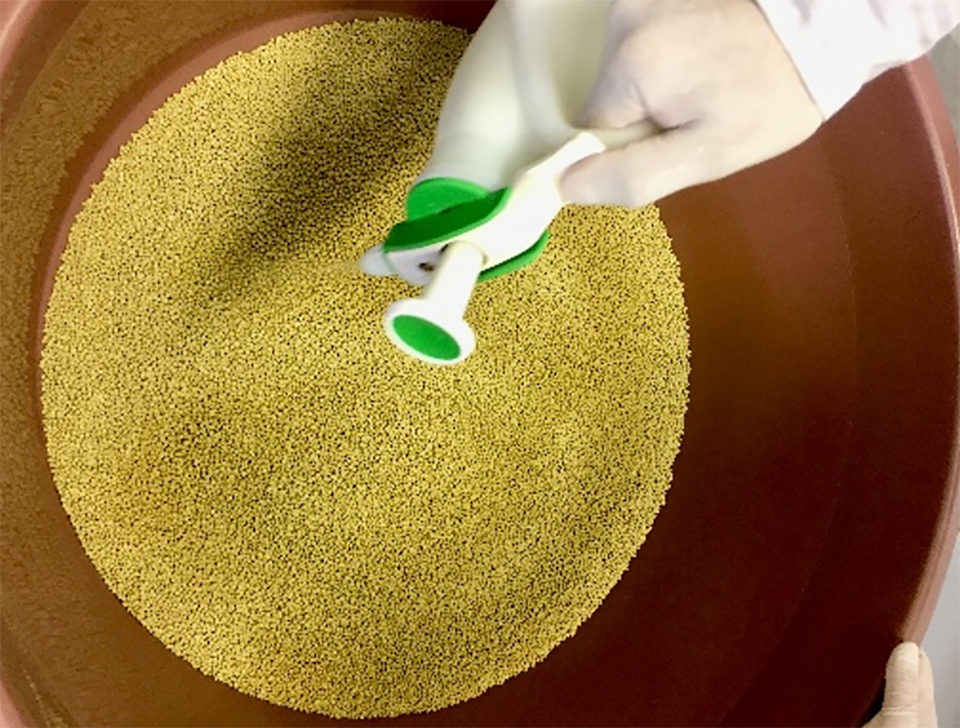
Four diets were formulated with 314.4 grams/kg of crude protein 18.8 MJ/kg of gross energy), containing two main sources of energy (corn or wheat bran) supplemented at two levels of xylanase and β-glucanase blend (non-supplemented or 0.2 grams/kg) from a commercial supplier (Natugrain® TS, BASF Corporation, Germany). The liquid blend of XBwas hand sprayed on extruded pellets and the enzymes’ activities were confirmed by laboratory analysis. At the end of the experimental trial, all fish were individually weighed.
Three fish from each aquarium were used for analysis of whole-body composition – moisture, crude protein, crude lipids and ash – and three fish were collected for blood analysis (aspartate aminotransferase, alanine aminotransferase, alkaline phosphatase, glucose, total protein, total cholesterol and triglycerides). All fish were fasted for 24 hours prior to blood sampling. Fish were anaesthetized and blood samples were collected from the caudal vein.
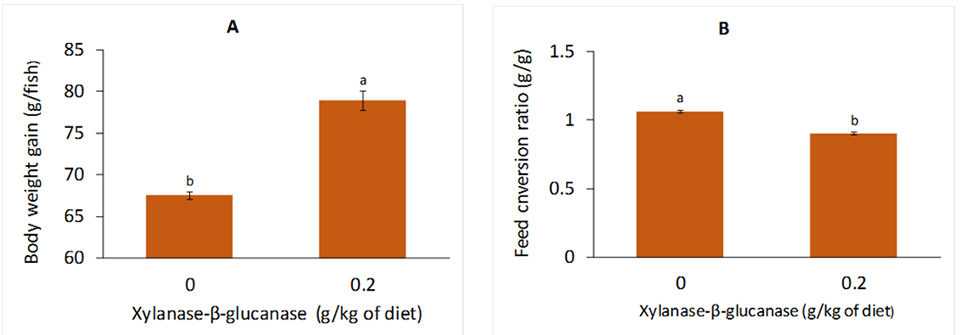
All data are presented as mean values ± standard error of mean (SEM) and subjected to one-way analysis of variance (ANOVA) to test the effects of the experimental diets using the statistical package SPSS. Tukey’s multiple range test at a level of significance of P< 0.05 was used to compare differences among treatment means.
Results

There was no interaction (P < 0.001) between diet type and XB supplementation on growth and feed conversion of fish. Body weight gain and feed conversion ratio did not vary (P > 0.05) among fish fed corn or wheat-based diets. However, fish fed the diet supplemented with XB had higher body weight gain and improved feed conversion ratio (P < 0.001) than those fish fed the diet that was not supplemented with the XB blend (Fig. 1).
No interactions (P < 0.001) were determined between diet type and XB supplementation on protein efficiency ratio, hepatosomatic index, visceral fat ratio, whole-body moisture, crude protein and crude lipids, blood glucose, cholesterol and triglycerides responses of fish, and they were not affected (P > 0.05) by dietary energy source. However, fish fed the diet supplemented with XB showed improved (P < 0.001) values of these variables compared to fish fed diet non-supplemented with XB diet. Feed intake, whole-body moisture, crude protein and ash content, and blood parameters of total protein, aspartate aminotransferase, alanine aminotransferase, and alkaline phosphatase did not differ (P > 0.05) among treatment groups. There was an interaction (P < 0.001) between diet type and XB on whole-body mineral retention. In this context, fish fed wheat-based diets containing XB had higher whole-body ash contents.
Perspectives
The inclusion of the XB blend we tested in our study may help reduce feed costs and contribute to support the sustainable production of tilapia. Apparently, diets with an inherently high nutritional value respond to a lower degree to NSP enzymes. Although xylanases have been found to be useful in corn-based diets, the magnitude of the response is reported generally to be lower than would be expected for wheat-based diets, especially considering the effects on the availability of minerals due to the difference in NSP type and concentration in corn compared to wheat.
It is, therefore, possible that the intestinal microbial profile might be affected with the dietary types and XB supplementation, but their potential effects require further investigation.
Authors
-
Johnny Martins de Brito, M.Sc.
Universidade Estadual de Maringá
Programa de Pós-Gradução em Zootecnia
Av. Colombo, 5790, 87020-270, PR, Brazil
(This study was financed in part by CAPES, Brazil – Finance Code 001) -
Tania Cristina Pontes, M.Sc.
Universidade Estadual de Maringá
Programa de Pós-Gradução em Zootecnia
Av. Colombo, 5790, 87020-270, PR, Brazil -
Dr. Valéria R. Barriviera Furuya
Universidade Estadual de Ponta Grossa
Departamento de Zootecnia
Av. Carlos Cavalcanti, 4748, 84030-900, PR, Brazil -
Dr. Alice Eiko Murakami
Universidade Estadual de Maringá
Programa de Pós-Gradução em Zootecnia
Av. Colombo, 5790, 87020-270, PR, Brazil -
Dr. Wilson Massamitu Furuya
Universidade Estadual de Ponta Grossa
Departamento de Zootecnia
Av. Carlos Cavalcanti, 4748, 84030-900, PR, Brazil
Tagged With
Related Posts

Aquafeeds
A look at protease enzymes in crustacean nutrition
Food digestion involves digestive enzymes to break down polymeric macromolecules and facilitate nutrient absorption. Enzyme supplementation in aquafeeds is a major alternative to improve feed quality and nutrient digestibility, gut health, compensate digestive enzymes when needed, and may also improve immune responses.
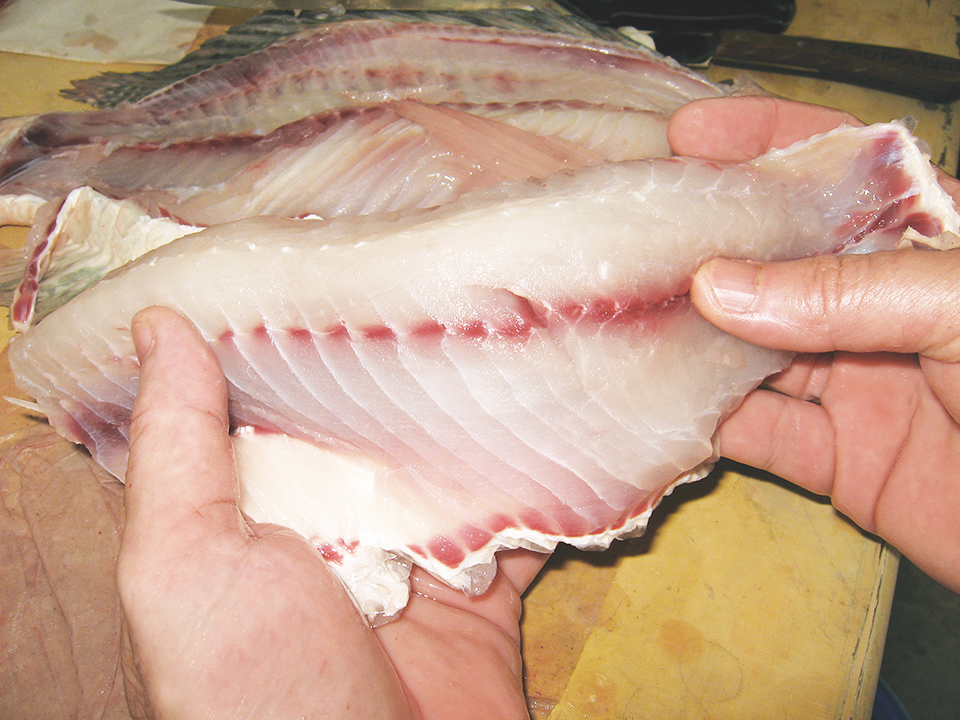
Health & Welfare
Cathepsin enzymes, part 1
Cathepsins B, D and L are considered critical in fish muscle post-mortem modifications or gel softening during the setting of surimi.

Health & Welfare
A holistic management approach to EMS
Early Mortality Syndrome has devastated farmed shrimp in Asia and Latin America. With better understanding of the pathogen and the development and improvement of novel strategies, shrimp farmers are now able to better manage the disease.
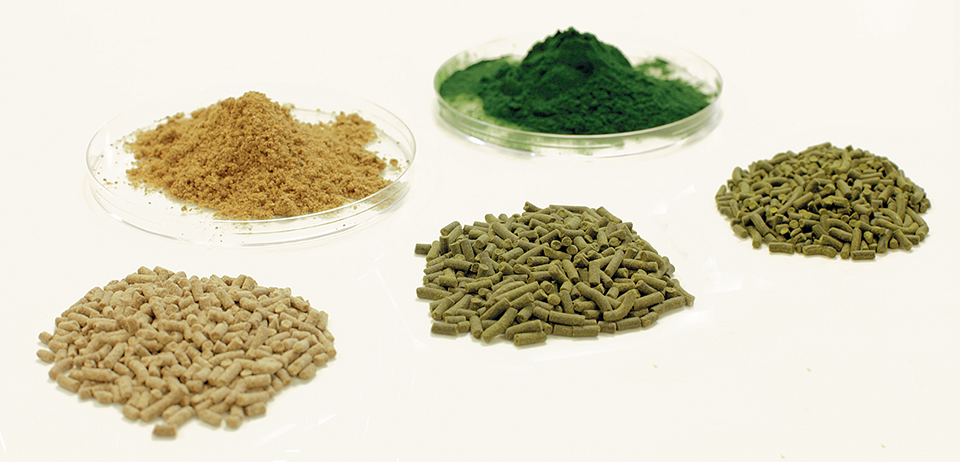
Aquafeeds
Algae alternative: Chlorella studied as protein source in tilapia feeds
Chlorella and other species have potential as protein sources in aquafeeds. In trials with tilapia fry raised in a recirculating system, the fish received a fishmeal-based control diet or feeds with portions of the fishmeal replaced by Chlorella.


